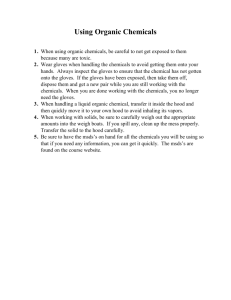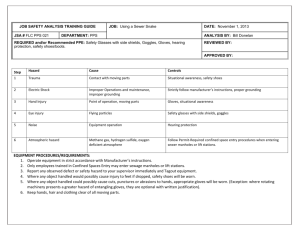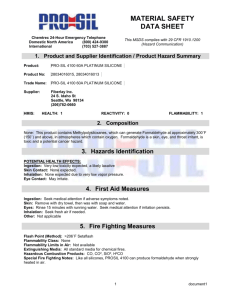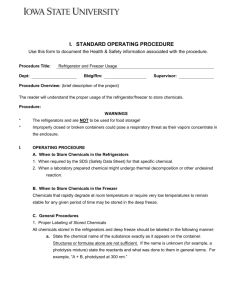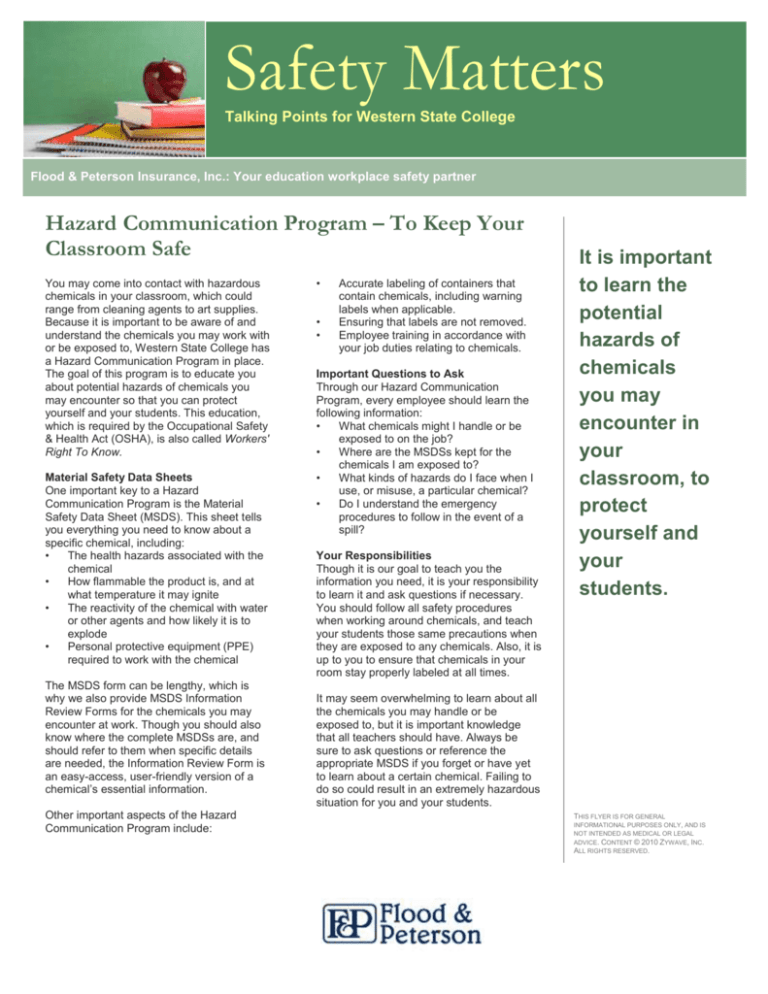
Safety Matters
Talking Points for Western State College
Flood & Peterson Insurance, Inc.: Your education workplace safety partner
Hazard Communication Program – To Keep Your
Classroom Safe
You may come into contact with hazardous
chemicals in your classroom, which could
range from cleaning agents to art supplies.
Because it is important to be aware of and
understand the chemicals you may work with
or be exposed to, Western State College has
a Hazard Communication Program in place.
The goal of this program is to educate you
about potential hazards of chemicals you
may encounter so that you can protect
yourself and your students. This education,
which is required by the Occupational Safety
& Health Act (OSHA), is also called Workers'
Right To Know.
Material Safety Data Sheets
One important key to a Hazard
Communication Program is the Material
Safety Data Sheet (MSDS). This sheet tells
you everything you need to know about a
specific chemical, including:
•
The health hazards associated with the
chemical
•
How flammable the product is, and at
what temperature it may ignite
•
The reactivity of the chemical with water
or other agents and how likely it is to
explode
•
Personal protective equipment (PPE)
required to work with the chemical
The MSDS form can be lengthy, which is
why we also provide MSDS Information
Review Forms for the chemicals you may
encounter at work. Though you should also
know where the complete MSDSs are, and
should refer to them when specific details
are needed, the Information Review Form is
an easy-access, user-friendly version of a
chemical’s essential information.
Other important aspects of the Hazard
Communication Program include:
•
•
•
Accurate labeling of containers that
contain chemicals, including warning
labels when applicable.
Ensuring that labels are not removed.
Employee training in accordance with
your job duties relating to chemicals.
Important Questions to Ask
Through our Hazard Communication
Program, every employee should learn the
following information:
•
What chemicals might I handle or be
exposed to on the job?
•
Where are the MSDSs kept for the
chemicals I am exposed to?
•
What kinds of hazards do I face when I
use, or misuse, a particular chemical?
•
Do I understand the emergency
procedures to follow in the event of a
spill?
Your Responsibilities
Though it is our goal to teach you the
information you need, it is your responsibility
to learn it and ask questions if necessary.
You should follow all safety procedures
when working around chemicals, and teach
your students those same precautions when
they are exposed to any chemicals. Also, it is
up to you to ensure that chemicals in your
room stay properly labeled at all times.
It is important
to learn the
potential
hazards of
chemicals
you may
encounter in
your
classroom, to
protect
yourself and
your
students.
It may seem overwhelming to learn about all
the chemicals you may handle or be
exposed to, but it is important knowledge
that all teachers should have. Always be
sure to ask questions or reference the
appropriate MSDS if you forget or have yet
to learn about a certain chemical. Failing to
do so could result in an extremely hazardous
situation for you and your students.
THIS FLYER IS FOR GENERAL
INFORMATIONAL PURPOSES ONLY, AND IS
NOT INTENDED AS MEDICAL OR LEGAL
ADVICE. CONTENT © 2010 ZYWAVE, INC.
ALL RIGHTS RESERVED.
MSDS Information Review Form
(Convert information from the chemical's MSDS)
Chemical common name: _________________________________ Review date ____________
Also known as: ____________________________________________________________
Hazard Rating Index
(Fill in from key below)
Health Hazard Rating
Flammability Hazard Rating
Reactivity Hazard Rating
Protective Equipment To Be Used
Hazard Rating Index Key:
Health Hazard:
4 - EXTREME:
Highly toxic: may be fatal on short-term exposure. Special protective equipment
required
3 - SERIOUS:
Toxic: avoid inhalation or skin contact
2 - MODERATE: Moderately toxic: may be harmful if inhaled or absorbed
1 - LIGHT:
Slightly toxic: may cause slight irritation
0 - MINIMAL:
All chemicals have some degree of toxicity
Flammability Hazard:
4
3
2
1
0
-
EXTREME:
SERIOUS:
MODERATE:
LIGHT:
MINIMAL:
Extremely flammable gas or liquid, flash point below 73° F
Flammable: flash point 73° F to 100° F
Combustible: requires moderate heating to ignite. Flash point 100° F to 200° F
Slightly combustible: requires strong heating to ignite
Will not burn under normal conditions
Reactivity Hazard:
4
3
2
1
0
-
EXTREME:
SERIOUS:
MODERATE:
LIGHT:
MINIMAL:
Explosive at room temperature
May explode, if shocked, heated under confinement or mixed with water
Unstable, may react with water
May react if heated or mixed with water
Normally stable, does not react with water
Protective Equipment (circle all that apply):
A - Safety Glasses
B - Safety Glasses, Gloves
C - Safety Glasses, Gloves, Synthetic Apron
D - Face Shield, Gloves, Synthetic Apron
E - Safety Glasses, Gloves, Dust Respirators
F - Safety Glasses, Gloves, Synthetic Apron, Dust Respirators
G - Safety Glasses, Gloves, Vapor Respirator
H - Splash Goggles, Gloves, Synthetic Apron, Vapor Respirators
I - Safety Glasses, Gloves, Dust & Vapor Respirator
J - Splash Goggles, Gloves, Synthetic Apron, Dust & Vapor Respirators
K - Air Line Hood or Mask, Gloves, Full Suit, Boots
X - Ask your supervisor for special handling instructions.
Z - None Required

